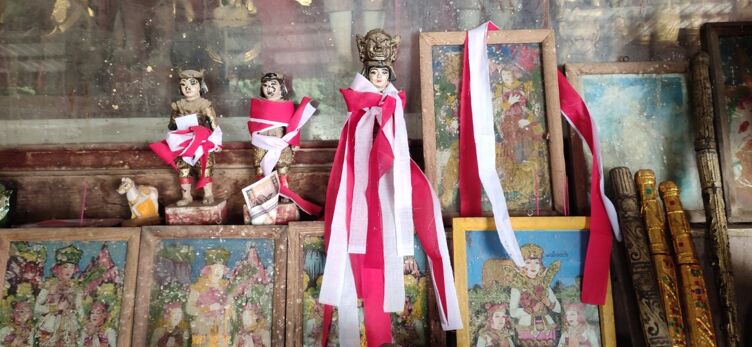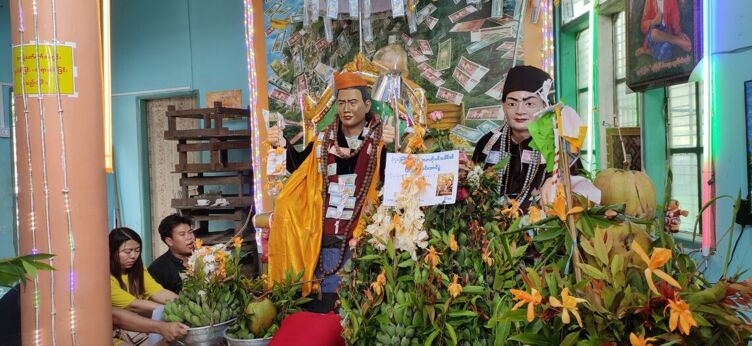With her wavy hair tied to a top knot, Linn Linn huddles on a carpet, her eyes closed and hands supplicating in prayer. A group of followers, middle-aged men and women, kneel around her in reverence, seeking blessings. Soon afterwards she dons a purple gaung baung (turban) and dances to a series of nat (spirit) music, starting with slow beats that gradually speed up. The moment ends with her entering a trance-like state.
Here in Amarapura – the former royal capital of Myanmar and now a dusty township situated by the Ayeyarwady River in the outskirts of Mandalay – Linn Linn is acting as a spirit medium, known as a nat kadaw (spirit wife), in a privately held nat pwè, or spirit appeasing ceremony.
Related:
The spectacular freedom of embracing she/he/they pronouns
My gender truly does feel all-encompassing. It’s fluid, it’s masculine, it’s feminine, it’s all of it, it’s none of it.
A nat, which translates to ‘lord’, is a spirit who has some dominion over a group of people or over a certain object or objects and has the power to benefit or harm people.
Never Miss a Beat
Subscribe to our newsletter to stay ahead of the latest LGBTQ+ political news and insights.
One year ago, the first time I met her, I watched Linn Linn in action as an adept makeup artist. She sat braiding her friend’s hari in her makeup parlor, a neat and tidy bamboo shed in a quiet corner of Taungbyone, a village 10 kilometers away from Mandalay, the second largest city in Myanmar.
In her mid-forties and always jovial, she juggles between being a makeup artist and nat kadaw. In fact, these are among the few professions that trans women like Linn Linn, called meinmasha in the Myanmar language, have unbridled access to.
An inner calling

The term meinmasha literally translates to ‘one imitating to be a woman’ or ‘one destined to be a woman’, with the connotation of a ‘male passive homosexual’ or ‘a gay who takes the role of a woman in a homosexual pair’.
Historically, nat kadaws were women, and spirit-mediumship was handed down hereditarily from mother to daughter. However, things started to change in the 1980s. According to a 2009 study by anthropologist Tamara C. Ho, since the 1980s the profession has been increasingly saturated by meinmashas, gender-fluid individuals, especially those assigned male at birth who identify as women. This has also resulted in an erroneous Western conflation of nat-kadaws with gay individuals.
In conservative Buddhist Myanmar, homosexuality is seen as a result of karma, stemming from sexual misconduct in past life. In addition to the social stigma, homosexuality remains illegal, with a British colonial-era penal code banning “carnal intercourse against the order of nature.” While the ban is seldom enforced, it effectively makes the LGBTQ+ community second-class citizens in the eyes of the law.
While overwhelmingly Theravāda Buddhist, a vast majority of Burmese simultaneously believe in the cult of toungze khunna min, 37 nat spirits. In fact, Melford E. Spiro, one of the foremost anthropologists to have studied Burmese culture, stated in the 1967 book Burmese Supernaturalism that the Burmese worldview “is informed not by one, but by two religious traditions, an indigenous spirit cult [nat] and one of the great world religions, Buddhism, an import from India … [with these being] two separate, albeit interrelated religions.”
It is commonly believed that nats benefit people when properly appeased. And to appease and communicate with nat spirits, one must go through nat kadaws who dance and speak with the spirits in a state of trance.
Yay Chan, a Burmese author from Mandalay, says, “Nat worshippers believe that nats can cure worries and help bring wealth and improve health. The nat kadaw speaks to the nat on behalf of the client.”
Typically, nat kadaws get paid around 10,000 kyats (about 5 USD) for answering one question for the client. In a country where the minimum monthly income is legislated at less than $70, this is a relatively good wage.
The primary reason behind meinmashas becoming nat kadaws, as noted by the acclaimed Burmese author Nu Nu Yi in her 2007 Man Asian Literary Prize-listed novel Smile as They Bow, is that the trans community finds freedom, acceptance, and dignity in this profession.
While they are stigmatized in everyday social life, the meinmasha nat kadaws are highly venerated during pwès as they are believed to have supernatural power.
“Among the believers, these nat kadaws command extraordinary respect as conduits between the human world and the supernatural,” says Yay Chan.
“However, this veneration is temporary and not everyone believes in nats in Myanmar. In general, these trans women still face discrimination.”
Nat kadaw Daisy Bond, the protagonist of Nu Nu Yi’s novel, describes the liberatory atmosphere that the nat pwè offers to the LGBTQ+ community:
When I first came to Taungbyone [the most prominent nat pwè in Myanmar], I just wanted to dress up like a woman. In my hometown, gay or not, I had to look like a man. . . But when I heard about the boys at Taungbyone, how they dressed and put on make-up whenever they pleased, all very happy and, well, gay. I just had to go see this Taungbyone for myself. I wasn’t a nat kadaw then, didn’t know a thing about nats… It’s not like I had a choice to become a nat kadaw or not. As soon as I set foot in Taungbyone, that nat blood, that nat spirit was in me. How could I see all that trance dancing and not picture myself possessed?
Linn Linn’s own experience mirrors that of the protagonist of Nu Nu Yi’s novel. “When I first went to Taungbyone nat pwè twenty-five years ago, I just went to visit as a young person. Once there, I realized my inner calling,” said Linn Linn, who originally hails from the Magway region.
“I am trapped in a male body. Growing up, I always felt like I was a girl, but I had to act like a man in my village,” she adds. “However, it was not long that I started becoming nwè.”
The Burmese term nwè is associated with effeminacy and roughly refers to feminine mannerisms in bodily practices.
“It increasingly became impossible to suppress my nwè and to act like a man. That’s when I decided I would become a nat-kadaw and make-up artist and finally I moved to Taungbyone.”
A suspension of normativity

As the LGBTQ+ community finds recluse in nat pwès and nat shrines, the earlier cisgender women nat-kadaws have been increasingly sidelined from the profession.
Min Min, a central character in Nu Nu Yi’s novel is seen lamenting, “…these old women natkadaws; they get so few followers these days, so few remain in Taungbyone. Gays are much better at pleasing people, they put on a better show. Times have changed: To be a nat kadaw today is to be gay…”
In one of her earlier stories published in 1994, The Neglected Wife or Pleasing the Nats, Nu Nu Yi had in fact portrayed the life of a woman nat-kadaw, a mother of three.
Hla Myat Tun, an LGBTQ+ activist in Yangon, has said there’s another factor triggering meinmashas into the nat kadaw profession. “There is a widespread notion that transgender women are cleaner than females, because they don’t have menstruation. Therefore, it’s cleaner for the nat to possess these bodies.”
While there’s no official estimate of the LGBTQ+ population in Myanmar, a majority of the community, especially the meinmasha trans women, find temporary employment and dignity in nat pwès and nat shrines. The most prominent of these nat pwès are held at Taungbyone, Taung Kalat, a sacred nat shrine near Mount Popa, and Amarapura.
Nat pwès are marked by the suspension of normativity. Anthropologist Tamara Ho writes, “Nat festivals provide a temporarily transformed sociality… a sanctioned space of transgenderism, where boys can dress up, put on makeup, and be ‘gay’.”















